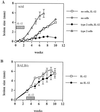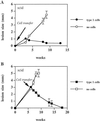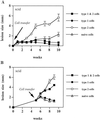Influence of parasite load on the ability of type 1 T cells to control Leishmania major infection
- PMID: 11796575
- PMCID: PMC127658
- DOI: 10.1128/IAI.70.2.498-503.2002
Influence of parasite load on the ability of type 1 T cells to control Leishmania major infection
Abstract
BALB/c mice infected with Leishmania major developed a type 2 immune response which failed to control parasite replication. We found that scid mice that received splenocytes from BALB/c mice that had been infected for 3 weeks with L. major (a type 2 cell population) and that were subsequently infected with L. major were protected when they were treated with interleukin 12 (IL-12). In contrast, IL-12 was ineffective at protecting BALB/c mice infected for 3 weeks, suggesting that a high parasite load regulates the development of protective immunity. To determine how this regulation operates, we performed a series of adoptive transfers of naïve, type 1 or type 2 splenocytes into scid mice. The recipient scid mice were infected either for 5 weeks prior to cell transfer (and thus had a high parasite load) or at the time of cell transfer. scid mice that were infected for 5 weeks and received a type 1 cell population were able to cure their lesions. However, when 5-week-infected scid mice received both type 1 and 2 cell populations, they were unable to control their infections. In contrast, the same type 1 and 2 cells transferred to naïve scid mice, which were subsequently infected, provided protection. In addition, we found that naïve cells mediated protection in scid mice with established lesions. These results show that high parasite numbers do not block type 1 protective responses or the development of type 1 responses. Instead, the influence of a high parasite load is dependent on the presence of a type 2 cell population.
Figures




Similar articles
-
Induction of a Th2 population from a polarized Leishmania-specific Th1 population by in vitro culture with IL-4.J Immunol. 1995 Apr 15;154(8):3779-87. J Immunol. 1995. PMID: 7706719
-
LeIF: a recombinant Leishmania protein that induces an IL-12-mediated Th1 cytokine profile.J Immunol. 1998 Dec 1;161(11):6171-9. J Immunol. 1998. PMID: 9834103
-
Regulatory interactions between CD45RBhigh and CD45RBlow CD4+ T cells are important for the balance between protective and pathogenic cell-mediated immunity.J Exp Med. 1994 Feb 1;179(2):589-600. doi: 10.1084/jem.179.2.589. J Exp Med. 1994. PMID: 7905019 Free PMC article.
-
Transfer of CD4+ T cells to C.B-17 SCID mice: a model to study Th1 and Th2 cell differentiation and regulation in vivo.Res Immunol. 1994 Jun;145(5):347-53. doi: 10.1016/s0923-2494(94)80198-3. Res Immunol. 1994. PMID: 7701113 Review. No abstract available.
-
Anti-leishmania effector functions of CD4+ Th1 cells and early events instructing Th2 cell development and susceptibility to Leishmania major in BALB/c mice.Adv Exp Med Biol. 1998;452:53-60. doi: 10.1007/978-1-4615-5355-7_7. Adv Exp Med Biol. 1998. PMID: 9889959 Review.
Cited by
-
Accelerated healing of cutaneous leishmaniasis in non-healing BALB/c mice using water soluble amphotericin B-polymethacrylic acid.Biomaterials. 2011 Nov;32(31):8029-39. doi: 10.1016/j.biomaterials.2011.07.021. Epub 2011 Jul 31. Biomaterials. 2011. PMID: 21807409 Free PMC article.
References
-
- Barral-Netto, M., A. Barral, C. E. Brownell, Y. A. W. Skeiky, L. R. Ellingsworth, D. R. Twardzik, and S. G. Reed. 1992. Transforming growth factor-β in leishmanial infection: a parasite escape mechanism. Science 257:545–548. - PubMed
-
- Bretscher, P. A., G. Wei, J. N. Menon, and H. Bielefeldt-Ohmann. 1992. Establishment of stable, cell-mediated immunity that makes “susceptible” mice resistant to Leishmania major. Science 257:539–542. - PubMed
-
- Critchfield, J. M., M. K. Racke, J. C. Zuniga-Pflucker, B. Cannella, C. S. Raine, J. Goverman, and M. J. Lenardo. 1994. T cell deletion in high antigen dose therapy of autoimmune encephalomyelitis. Science 263:1139–1143. - PubMed
Publication types
MeSH terms
Substances
Grants and funding
LinkOut - more resources
Full Text Sources

